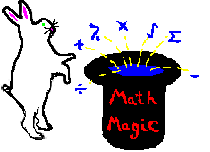

A. There are certain numbers that when divided by, we can make it easier by changing it to a multiplication problem.
B. The hardest part of this type of problem is finding the number of digits the answer is supposed to have.
C. Below is a list of specific numbers that can be changed:
Specific Number/Number Multiply By
| 5 | 2 | 125 | 8 |
| 333... | 3 | 111... | 9 |
| 25 | 4 | 9090... | 11 |
| 2 | 5 | 833... | 12 |
| 166... | 6 | 666... | 15 |
| 142857... | 7 | 4 | 25 |
Notice that 1/.5 = 2, 1/.333... = 3, 1/.25 = 4, etc.
1. To find the approximate answer take the first 2 digits (rounded) out of the question and multiply by its corresponding number from the chart. (*Be careful not to put more digits than the answer requires.*)
2. To find out how many digits the answer will have, subtract the number of digits the divisor has from the number of digits the dividend has and add 1. If the divisor CANNOT go into the same number of digits of the dividend at least once, then do not add 1 in the end.
Ex [1] 1033994 ÷ 333 = __________.
a. In this example the number 333 cannot divide into 103 at least once, so the number of digits the answer will have will be 7 (the number of digits of the dividend) minus 3 (the number of digits in the divisor).
b. The number of digits of the answer is 4.
Ex [2] 923823 ÷ 143 = ___________.
a. In this example the number 143 can divide into 923 at least once, so the number of digits the answer will have is 6 - 3 + 1or 4.
D. Here are a few examples to illustrate the above steps:
Ex [3] 1938833 ÷ 109 = __________.
a. In this example, 109 is very close to 111, so we can multiply by 9.
b. Taking the first 2 digits we get 19. 19 x 9 = 171.
c. To find the number of digits, we use 7 - 3 + 1 or 5.
d. The answer is 17100 (add enough 0's on the end to take up any extra place values.)
e. The answer can be between 16989 and 18676.
Ex [4] 2092391 ÷ 911 = __________.
a. In this problem, 911 is close to 909, so we can multiply by 11.
b. Rounding the first two digits we get 21. 21 x 11 = 231.
c. To find the number of digits, we use 7 - 3 = 4. (Notice 911 cannot divide into 209 at least once.)
d. The answer we get is 2310.
e. The answer can be between 2182 and 2411.
E. When doing problems in this manner, you have to use good judgment. If you round the dividend and round the divisor sometimes your answers can become skewed. If the answer is going to smaller, take the time to decide if what you are doing is wise.